
Law Firm SEO: Common Issues and Missed Opportunities

Law seems to be a discipline that is as old as time, however, every major law firm knows that they have to step into the modern world and become increasingly digital if they want to succeed and gain clients.
Over the last few months, we have been conducting SEO audits of top firms from various industries to see the SEO gains and pitfalls each have succumb to. So far, we have looked at accountancy firms, marketing companies, and now law firm SEO. Here is a link to each of the other studies in case you are interested:
Being an industry that establishes right from wrong, it is perhaps expected that when it comes to law firm SEO, everything would be above board (meaning no black-hat SEO). However, we found that this was not always the case – About 10% of the sites audited looked like they had potentially received a Google penalty. Not only were some dodgy tactics used to try and outrank the competition, but there were many SEO opportunities missed by firms on the second and third pages of Google that could help them rank higher for relevant key terms.
TABLE OF CONTENTS
1. About the SEO audit
2. The biggest issues with law firm SEO
3. Things that law firms were doing well
About the SEO audit:
We usually have a set routine when it comes to auditing a potential client’s site for SEO issues, and we used this same method when checking the SEO efforts of over 30 top Law firms.
Initially, to identify the firms we wanted to assess, we typed the keyword “Law firm” into SEMRush and exported the first three pages of law firms from the search engine results page (SERP).

Then we got to work.
Typically, in an SEO health check, we look at:
- How quickly a website loads – on desktop and mobile.
- How well the meta tags have been written (meaning the meta title and description and whether these are being used to help Google and the searcher better understand the page).
- If pages have been optimised for keywords- for law firms, these keywords could include “family law” or variations such as “family law services”.
- It is also important to see evidence of internal linking- this means checking if key terms are linking to relevant pages on the same site. For instance, a page that talks generally about family law services, should link the words “divorce lawyers” to a specific page about this topic- it helps improve the site’s architecture and will improve rankings.
- We check that the content on the website doesn’t feature anywhere else- Google does not like duplicate content.
- We make sure every page on the site is relevant and contributes to overall user experience.
- We look at inbound anchor text for any over-optimisation or dodgy link building (trust us, it’s pretty obvious!)
- We look at a website’s traffic to identify any sudden and sharp decreases in visitors- as this could indicate that Google has issued a penalty which stops the site from appearing on the SERP
- We also look at any pages that are indexed by Google that shouldn’t be – printer-friendly pages for example.
- We will assess how trustworthy a site seems to a first-time visitor. We do this by seeing if the site has an SSL certificate (meaning they have a secure connection with https appearing before their URL), and also checking for evidence of social media, an ‘about’ page, contact information and perhaps even a blog or news section.
The Biggest Issues with Law Firm SEO
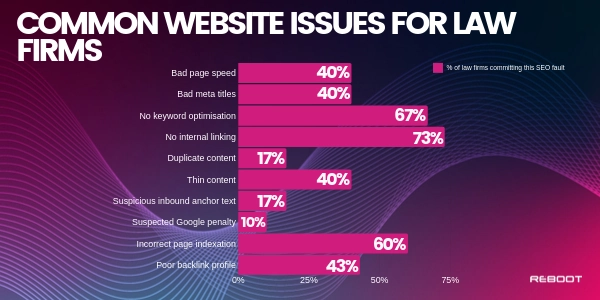
Our audits revealed that the most common SEO issues were:
- Lack of internal linking – 73% have not linked to other pages within their website
- Pages not keyword optimised – 67% have not conducted proper keyword research
- Incorrect indexing of pages – 60% of law firms had pages indexed on Google that should not have been
- Poor meta titles – 40% of the sites analysed had not structured their meta titles effectively.
- Pages with nothing of value – around 40% of law firms waste their crawl budget on so-called ‘thin content’.
Let’s take a closer look at the specific law firm SEO issues:
Lack of internal linking:
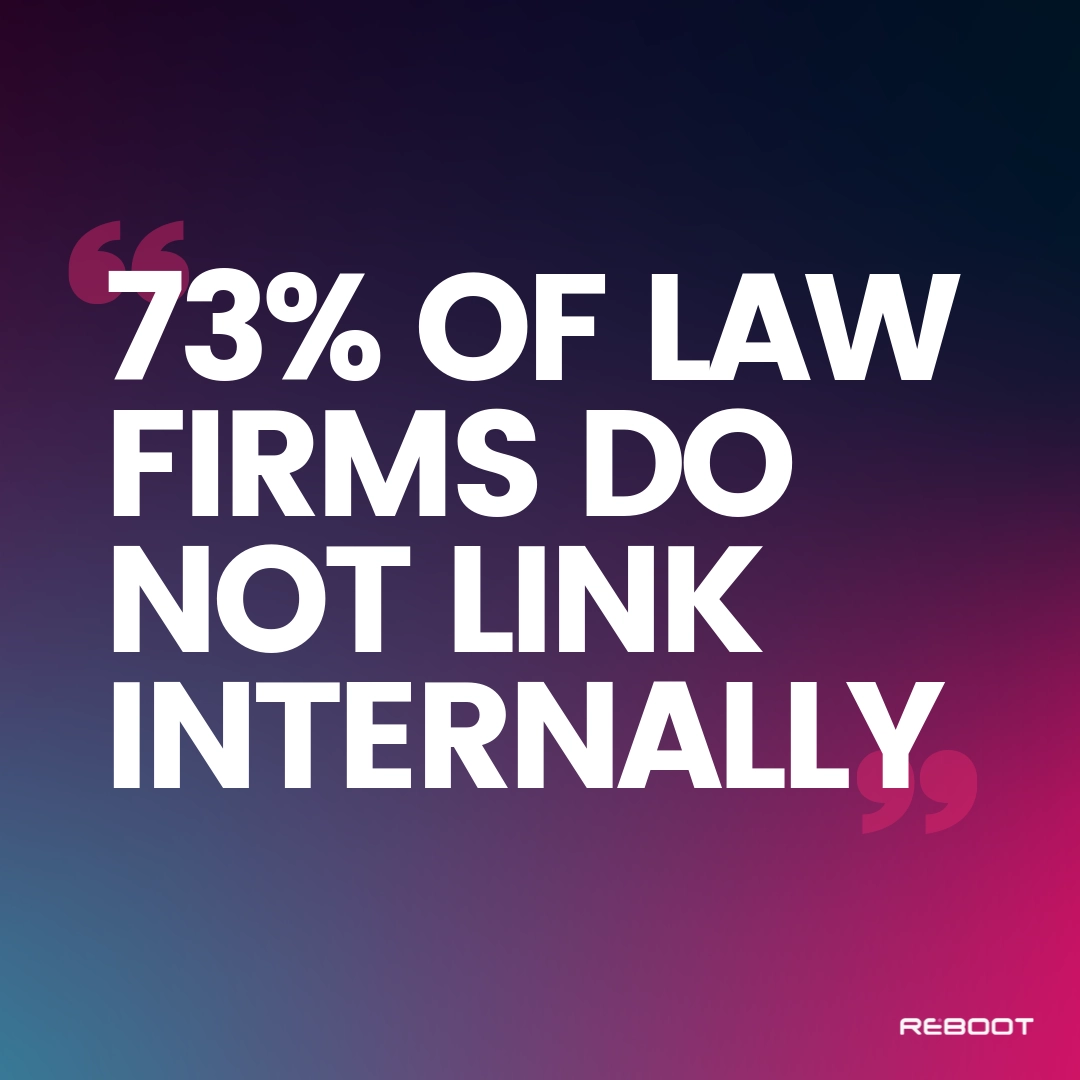 Only 27% of firms we analysed had remembered to use descriptive anchor text to link to another page on their website. For those neglecting this important element of SEO, they are preventing a flow of traffic through their website and stopping the spread of authority from any backlinks a page receives.
Only 27% of firms we analysed had remembered to use descriptive anchor text to link to another page on their website. For those neglecting this important element of SEO, they are preventing a flow of traffic through their website and stopping the spread of authority from any backlinks a page receives.
Using the example from earlier, a page on Family Law may have been referenced by an online article in a law publication. This tells Google you are a good resource on Family Law. If you then internally link from this service page, to another page, perhaps to ‘divorce lawyers’, you help spread the authority of that one law publication backlink throughout your site – helping you rank for key terms like “divorce lawyers” and overall increasing the chances of your pages ranking in Google.
Internal linking is also useful to help users navigate your website. This is particularly useful on the blog, to help searchers go from an informational post to a more commercial page, such as one where they can contact the type of lawyer they are looking for.
We can see a missed opportunity for an internal link on the law firm site WithersWorldwide.

I have underlined the perfect opportunity to push a blog post reader over onto their family law page, and help them go further through the buyer’s journey- from someone just seeking information, to browsing pages with more commercial intent.
Not properly keyword-optimised
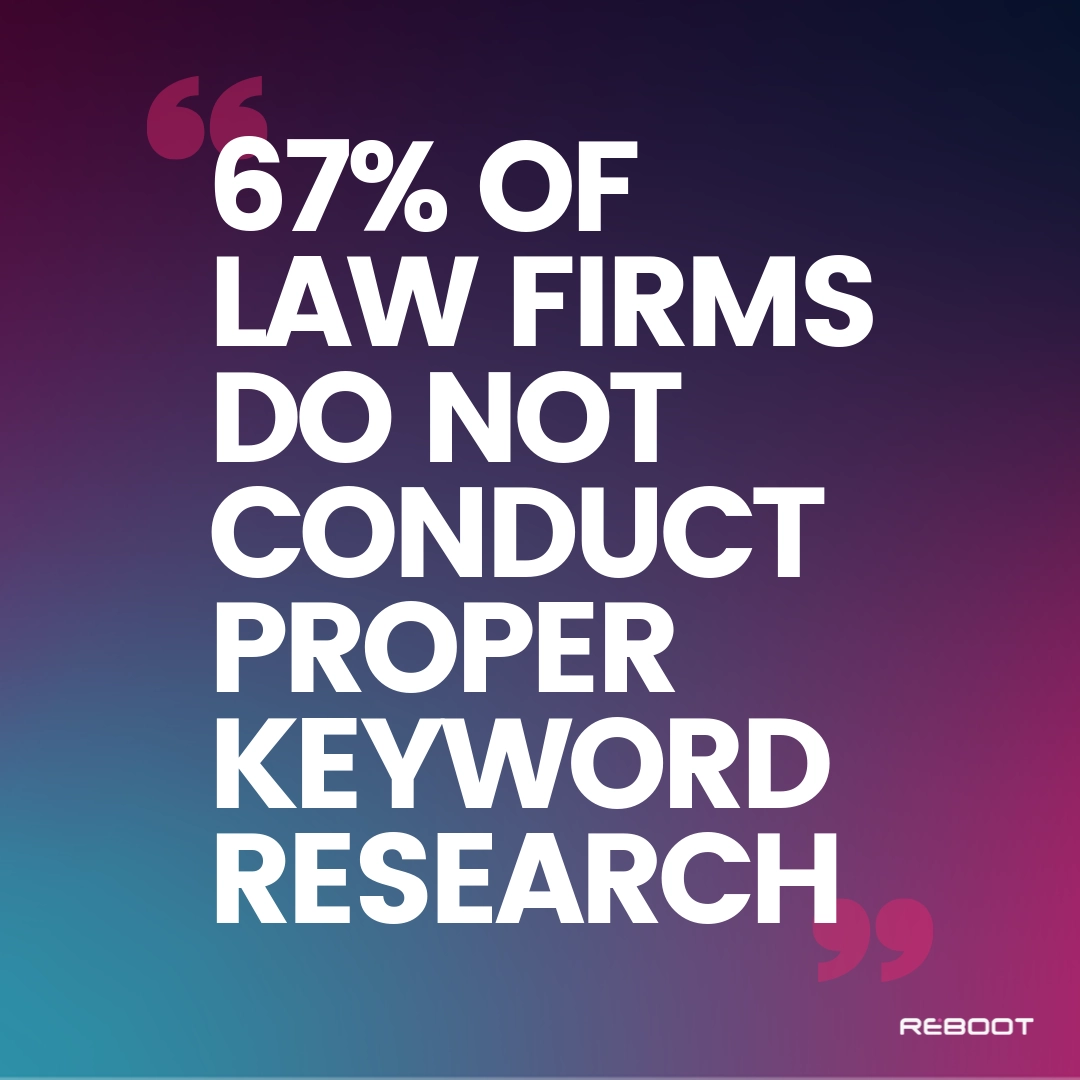
According to our study, only 33% of firms had correctly optimised their service pages for relevant keywords. If you want your law firm to be found by potential clients on Google, you have to help Google know which pages they should rank for which keywords. This is done through keyword research and on-page optimisation.
We discovered that, perhaps unsurprisingly, the higher your Google ranking the more likely you were to have keyword-optimised pages. For instance, 50% of law firms featuring on page 1 on Google had evidence of good keyword research- whereas only 21% of the sites on page 3 could say the same.
We can see an example of keyword optimisation issues on the corporate law page on firm KLC’s website.
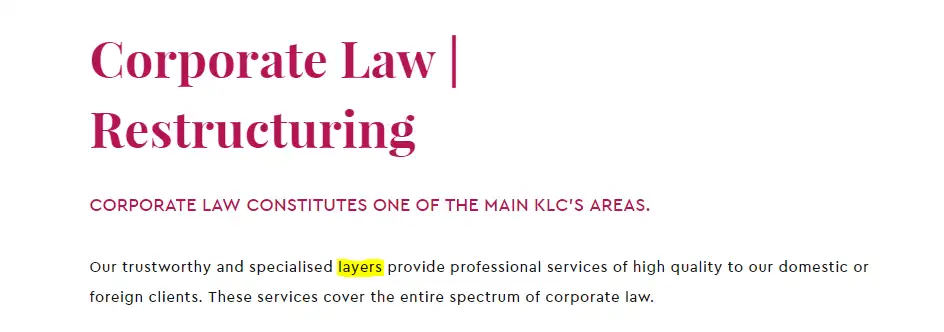 Of course, the spelling mistake highlighted means they may find it tough to rank, but the page does mention “corporate law” – so surely Google will understand what the page is about? While this is true, there are some missed opportunities on the page to play around with keyword variations such as “corporate law specialists” or “corporate law services” – this would help Google rank you for all of these terms, and make it appear that you cover the topic thoroughly. This is especially important in a field such as law, where the topics and legalities can be quite vast.
Of course, the spelling mistake highlighted means they may find it tough to rank, but the page does mention “corporate law” – so surely Google will understand what the page is about? While this is true, there are some missed opportunities on the page to play around with keyword variations such as “corporate law specialists” or “corporate law services” – this would help Google rank you for all of these terms, and make it appear that you cover the topic thoroughly. This is especially important in a field such as law, where the topics and legalities can be quite vast.
Pages indexed by Google that shouldn’t be
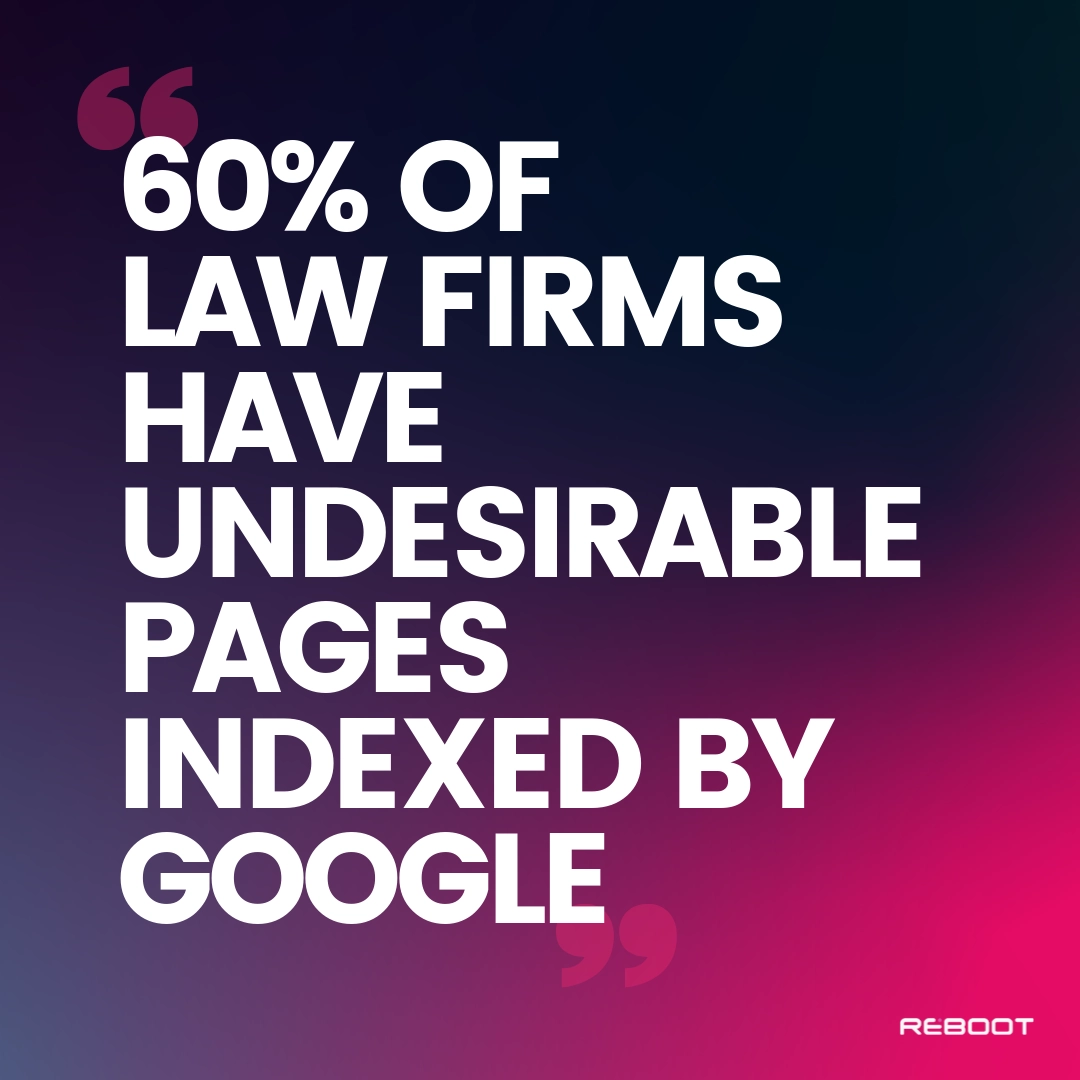 We found out that a whopping 60% of law firm SEO had pages indexed by Google that should not have been.
We found out that a whopping 60% of law firm SEO had pages indexed by Google that should not have been.
In order to look for these pages on your own site, simply type “site: + your domain (eg: rebootonline.com)” into Google, and browse all the pages you have indexed for your site.
Take a look for pages you don’t want to be indexed.
This is always good practice. The problem with Google listing pages on the search results that do not need to be there is that this wastes your so-called “crawl budget”.
Crawl budget is the number of pages a bot can crawl and index in any given time.
This means, if you waste your crawl budget on irrelevant pages, you are preventing Google from indexing your high-priority, high buyer intent pages. Why send your traffic to empty pages unlikely to convert?
We found an example of this SEO issue upon doing a ‘site:’ command’ on the firm ODI law, we found the following result:
 The indexing of the page “home-2” is problematic as it could cause internal competition with the main home page, or Google could see the content as duplicate, and choose to hide one of the results.
The indexing of the page “home-2” is problematic as it could cause internal competition with the main home page, or Google could see the content as duplicate, and choose to hide one of the results.
Poor meta tags: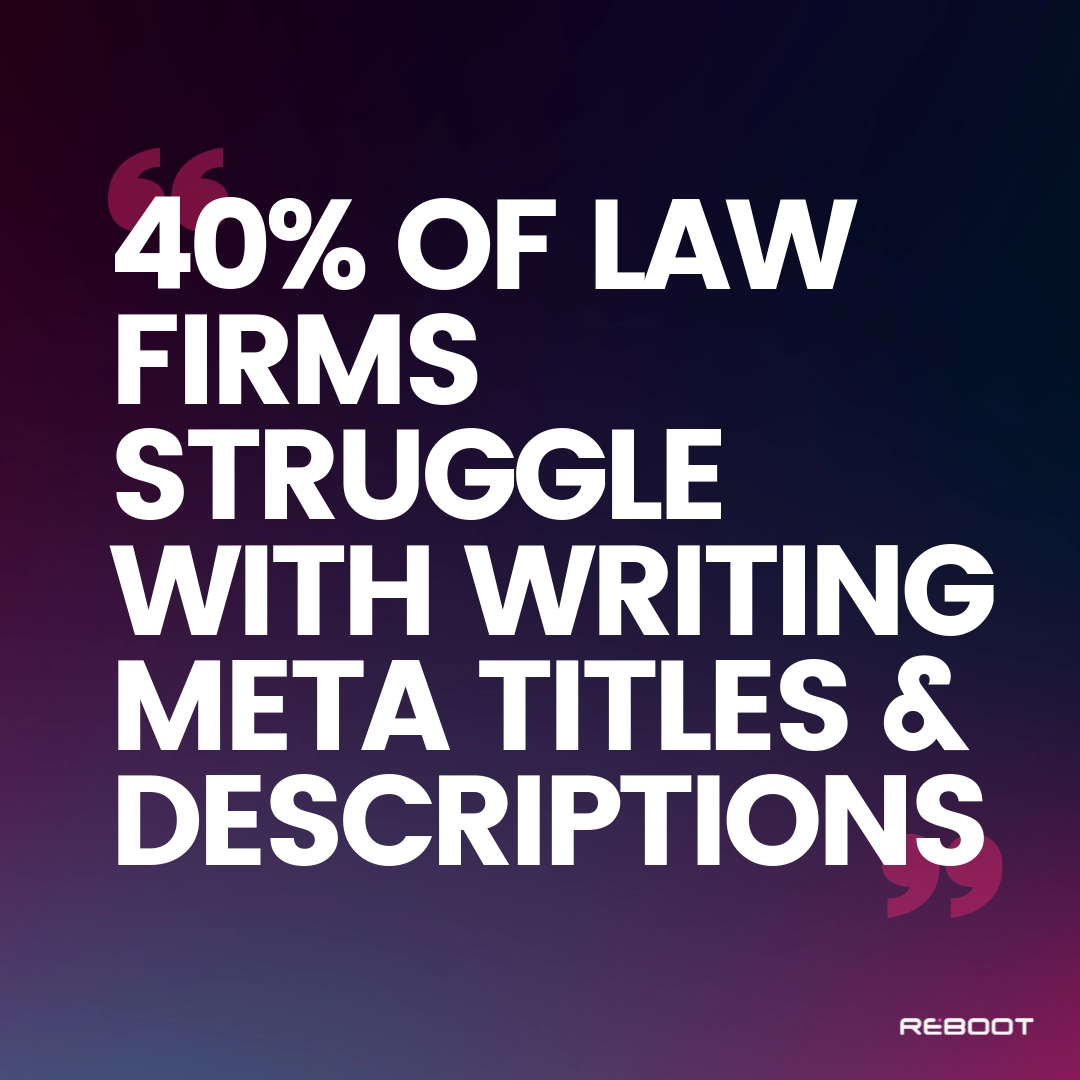
Our audits revealed that 40% of top law firms struggle with writing their meta titles and meta descriptions.
Meta tags are the clickable title and description for a page that shows on a Google search result’s page.
It is important to get meta tags right as you can do all the keyword research and optimisation you want, but if you don’t entice a searcher to click your result then, with a low click through rate (CTR), Google may think you are undeserving of a top ranking spot.
We saw an example of ineffective meta title on law firm Jackson Law.
 Not only does the meta title look jam-packed and unenticing, but it’s stuffed with keywords, making the page look spammy. Jackson Law would have been better off using these best practices for meta titles:
Not only does the meta title look jam-packed and unenticing, but it’s stuffed with keywords, making the page look spammy. Jackson Law would have been better off using these best practices for meta titles:
1. Stick to 50-60 characters for your title - Any more and Google will cut it off, so make sure the searcher sees the most important elements of your page within 50-60 characters.
2. Do not stuff with keywords - it’s best to keep the keyword at the start of your title, but it’s bad user experience to include a list of keywords and variations as a meta title.
3. Make sure the title describes the page - if you are appearing on the SERP for a certain query, then you want to show the searcher that they will find the answer for that query by clicking on your result. Stating things like “home page” or “blog page” won’t make a searcher click through to your site.
Thin content
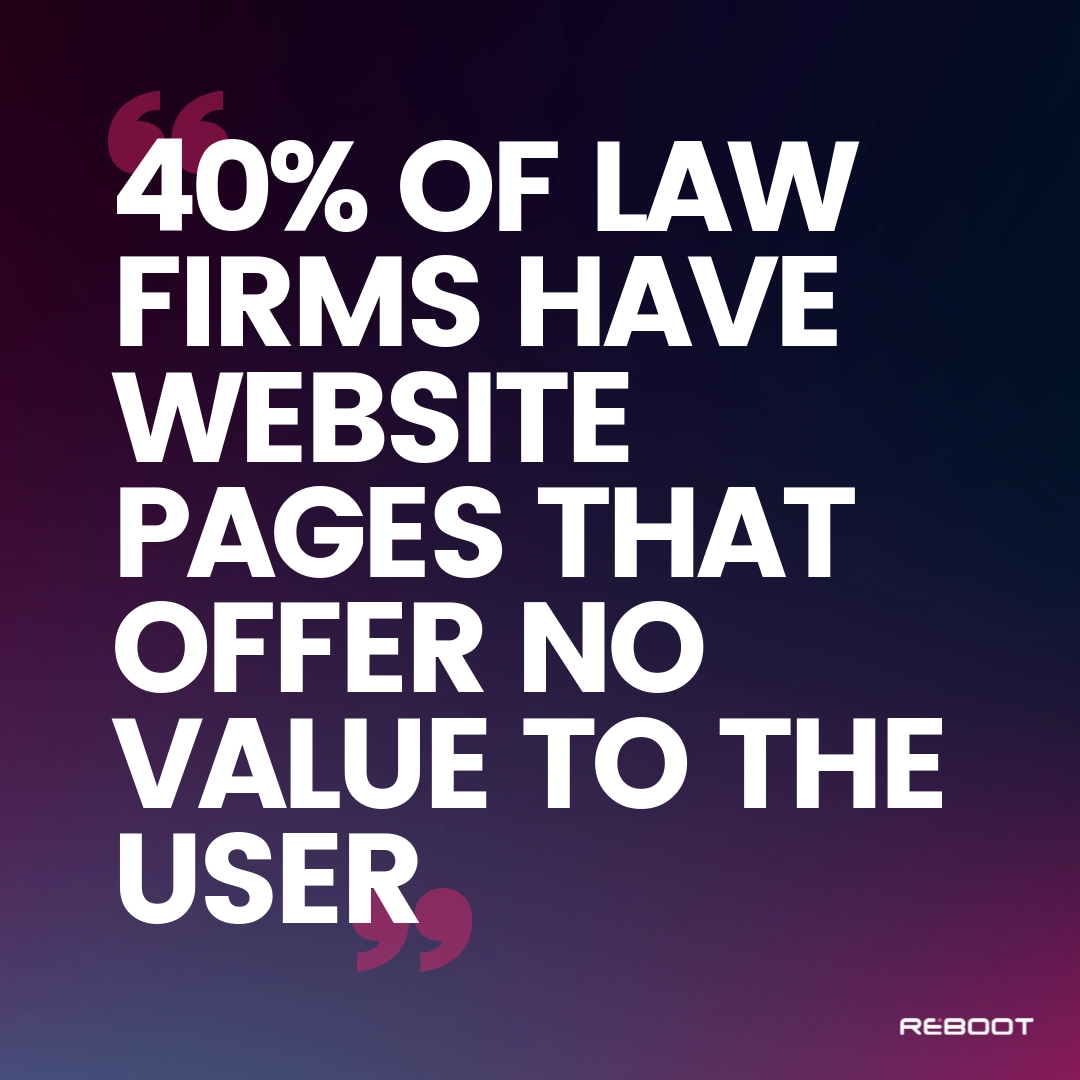
The importance of providing genuinely useful content to searchers cannot be stressed enough, yet 4 in 10 law firm websites audited had pages on their site that provided nothing of value. Thin content includes things like auto-generated content, website content scraped from elsewhere, or any page with nothing of value on it.
An example of thin content can be seen of the website Wedlake Bell

This page provides an image of what appears to be some floorboards, and not much else.
Thin content not only harms conversion rate- as you leave website visitors with nothing to engage with, and nothing to call them to action, but it can also harm your brand reputation. Blank pages, or ones with incorrect/little content can seem unprofessional - so it’s best to do something about it.
If you identify thin content on your site, we suggest adding content to the page that:
1. Satisfies search intent
2. Is evergreen (meaning the content won’t date)
3. Is keyword optimised
4. Provides great user experience
SEO that law firms were doing well
Although we can see that the audits highlighted issues with law firm SEOs, they also revealed a few positives:
-
Page speed: Law firm sites tended to have good page speed. This means their PageSpeed Insights’ score was over the average of 50. In fact 60% gained an average-to-good score. The overall average speed of the sites we analysed was 51, however for the sites that made it to page 1 in Google’s ranking, this speed score went up to 65. If you are a law firm looking to increase your rankings, it could make sense to have your SEO company start with the speed of your site.
-
Backlink profile: We noted that 57% of law firms had successfully secured decent links back to their site- which is a great trust signal to Google, and will help you rank higher on the SERP. However, 17% of websites analysed showed evidence of suspicious anchor text- meaning they may have paid for the links, going against Google’s guidelines.
-
Good trust signals: The majority of sites proved to appear trustworthy to a first-time visitor. This included great EAT signals (Expertise, Authority and Trust).
-
100% of the sites had a blog or news page
-
90% had social media channels advertised on their site
-
87% had a contact page (although 13% did not!)
-
87% had an SSL certificate
-
90% had an ‘about’ page
-

